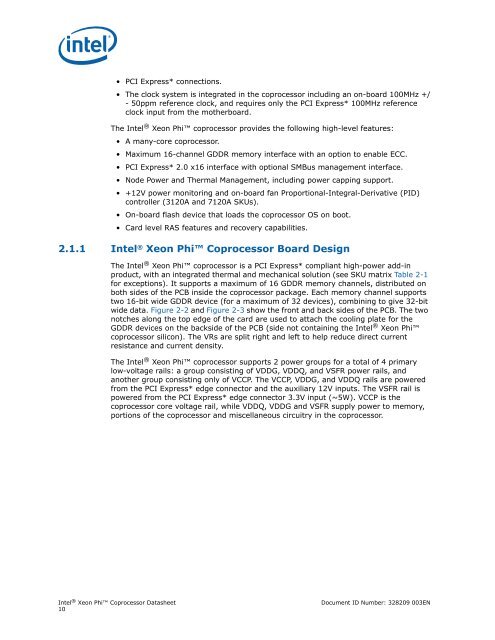Xeon-Phi-Coprocessor-Datasheet
Xeon-Phi-Coprocessor-Datasheet
Xeon-Phi-Coprocessor-Datasheet
You also want an ePaper? Increase the reach of your titles
YUMPU automatically turns print PDFs into web optimized ePapers that Google loves.
• PCI Express* connections.<br />
• The clock system is integrated in the coprocessor including an on-board 100MHz +/<br />
- 50ppm reference clock, and requires only the PCI Express* 100MHz reference<br />
clock input from the motherboard.<br />
The Intel ® <strong>Xeon</strong> <strong>Phi</strong> coprocessor provides the following high-level features:<br />
• A many-core coprocessor.<br />
• Maximum 16-channel GDDR memory interface with an option to enable ECC.<br />
• PCI Express* 2.0 x16 interface with optional SMBus management interface.<br />
• Node Power and Thermal Management, including power capping support.<br />
• +12V power monitoring and on-board fan Proportional-Integral-Derivative (PID)<br />
controller (3120A and 7120A SKUs).<br />
• On-board flash device that loads the coprocessor OS on boot.<br />
• Card level RAS features and recovery capabilities.<br />
2.1.1 Intel ® <strong>Xeon</strong> <strong>Phi</strong> <strong>Coprocessor</strong> Board Design<br />
The Intel ® <strong>Xeon</strong> <strong>Phi</strong> coprocessor is a PCI Express* compliant high-power add-in<br />
product, with an integrated thermal and mechanical solution (see SKU matrix Table 2-1<br />
for exceptions). It supports a maximum of 16 GDDR memory channels, distributed on<br />
both sides of the PCB inside the coprocessor package. Each memory channel supports<br />
two 16-bit wide GDDR device (for a maximum of 32 devices), combining to give 32-bit<br />
wide data. Figure 2-2 and Figure 2-3 show the front and back sides of the PCB. The two<br />
notches along the top edge of the card are used to attach the cooling plate for the<br />
GDDR devices on the backside of the PCB (side not containing the Intel ® <strong>Xeon</strong> <strong>Phi</strong><br />
coprocessor silicon). The VRs are split right and left to help reduce direct current<br />
resistance and current density.<br />
The Intel ® <strong>Xeon</strong> <strong>Phi</strong> coprocessor supports 2 power groups for a total of 4 primary<br />
low-voltage rails: a group consisting of VDDG, VDDQ, and VSFR power rails, and<br />
another group consisting only of VCCP. The VCCP, VDDG, and VDDQ rails are powered<br />
from the PCI Express* edge connector and the auxiliary 12V inputs. The VSFR rail is<br />
powered from the PCI Express* edge connector 3.3V input (~5W). VCCP is the<br />
coprocessor core voltage rail, while VDDQ, VDDG and VSFR supply power to memory,<br />
portions of the coprocessor and miscellaneous circuitry in the coprocessor.<br />
Intel ® <strong>Xeon</strong> <strong>Phi</strong> <strong>Coprocessor</strong> <strong>Datasheet</strong><br />
10<br />
Document ID Number: 328209 003EN


